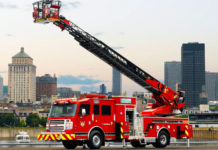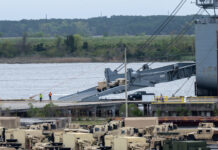By Danica Coto, The Associated Press
The sky was darkening Thursday afternoon as 10-year-old Sarah Jimenez laid out three plastic buckets on her grandmother’s patio in hopes of capturing rainwater.
“We can use it to at least flush the toilets,” she told her grandmother.
A day after Hurricane Maria ravaged Puerto Rico, flooding towns, crushing homes and killing at least two people, millions of people on the island faced the dispiriting prospect of weeks and perhaps months without electricity.
The storm knocked out the entire grid across the U.S. territory of 3.4 million, leaving many without power to light their homes, cook, pump water or run fans, air conditioners or refrigerators.
As a result, Jimenez and others hunted for gas canisters for cooking, collected rainwater or steeled themselves mentally for the hardships to come in the tropical heat.
Some contemplated leaving the island.
(Hurricane Maria caused widespread flooding and damage after pounding Puerto Rico as a Category 4 storm. Rescue crews have fanned out across the U.S. territory as it tries to rebuild amid an economic crisis. Courtesy of The Associated Press and YouTube. Posted on Sep 21, 2017)
“You cannot live here without power,” said Hector Llanos, a 78-year-old retired New York police officer who planned to leave Saturday for the U.S. mainland to live there temporarily.
 Like many Puerto Ricans, Llanos does not have a generator or gas stove.
Like many Puerto Ricans, Llanos does not have a generator or gas stove.
“The only thing I have is a flashlight,” he said, shaking his head.
“This is never going to return to normal.”
Maria’s death toll across the Caribbean, meanwhile, climbed to at least 19, nearly all of them on the hard-hit island of Dominica.
In Puerto Rico, the government said at least two were killed but media on the island were reporting additional deaths and the actual toll appeared unlikely to be known for days.
As of Thursday evening, Maria was moving off the northern coast of the Dominican Republic with winds of 120 mph (195 kph).
(Hurricane Maria cut a path of destruction through Puerto Rico and gained speed as it is expected to turn north along the US east coast. Courtesy of CNN and YouTube. Posted on Sep 21, 2017)
The storm was expected to approach the Turks and Caicos Islands and the Bahamas late Thursday and early Friday.
From there, it is expected to veer into the open Atlantic, no threat to the U.S. mainland.
In Puerto Rico, the grid was in sorry shape long before Maria — and Hurricane Irma two weeks ago — struck.

The territory’s $73 billion debt crisis has left agencies like the state power company broke.
It abandoned most basic maintenance in recent years, leaving the island subject to regular blackouts.
“We knew this was going to happen given the vulnerable infrastructure,” Gov. Ricardo Rossello said.
The Federal Emergency Management Agency said it would open an air bridge from the mainland on Friday, with three to four military planes flying to the island every day carrying water, food, generators and temporary shelters.
“There’s a humanitarian emergency here in Puerto Rico,” Rossello said.
“This is an event without precedent.”
 He said his administration was trying to open ports soon to receive shipments of food, water, generators, cots and other supplies.
He said his administration was trying to open ports soon to receive shipments of food, water, generators, cots and other supplies.
The government has hired 56 small contractors to clear trees and put up new power lines and poles and will be sending tanker trucks to supply neighborhoods as they run out of water.
The entire island has been declared a federal disaster zone.
Mike Hyland, senior vice president of engineering services for the American Public Power Association, a utility industry group that is sending repair crews into the Caribbean, refused to speculate on how long it would take to restore power in Puerto Rico.
“Let’s see what the facts tell us by the end of the weekend,” he said.

But he acknowledged: “This is going to be a tall lift.”
Sarah’s grandmother, Maribel Montilla, already had two large barrels filled with water but worried about how long it would last for her, her daughter, her son-in-law and six grandchildren.
“You know what I think? We’re going to be without power for six months now,” she said.
Cellphone and internet service collapsed in much of Puerto Rico.
The only radio station that remained on the air during the hurricane — WAPA 680 AM — was relaying messages to help connect friends and families.
Other concerns were more prosaic. Across the street, someone yelled at a neighbor, “Listen, do you have Netflix?!”
(On the island of Dominica, nearly complete destruction by Hurricane Maria. At least 15 people are dead, and many others are missing. Courtesy of ABC News and YouTube. Posted on Sep. 21, 2017.)
Jaime Rullan, a sports commentator, has a gas stove at home but tried not to think about the lack of air conditioning on an island where the heat index has surpassed 100 degrees (37 Celsius) in recent days.
“We’re used to the lights going out because of storms here in Puerto Rico, but this time, we’re worried,” he said.

“We should prepare ourselves mentally to be at least a month without power.”
Deysi Rodriguez, a 46-year-old caretaker for elderly people, does not have a gas stove.
And unlike others who have been lining up at the few fast-food restaurants that have reopened, Rodriguez is a diabetic and has to be more careful about what she eats.
Rodriguez said she might temporarily move to New Jersey if the situation gets worse.
Original post https://apnews.com/ab73f572a6824318a5f7b460ca83b7be/Powerless:-Puerto-Rico-faces-weeks-without-electricity
















